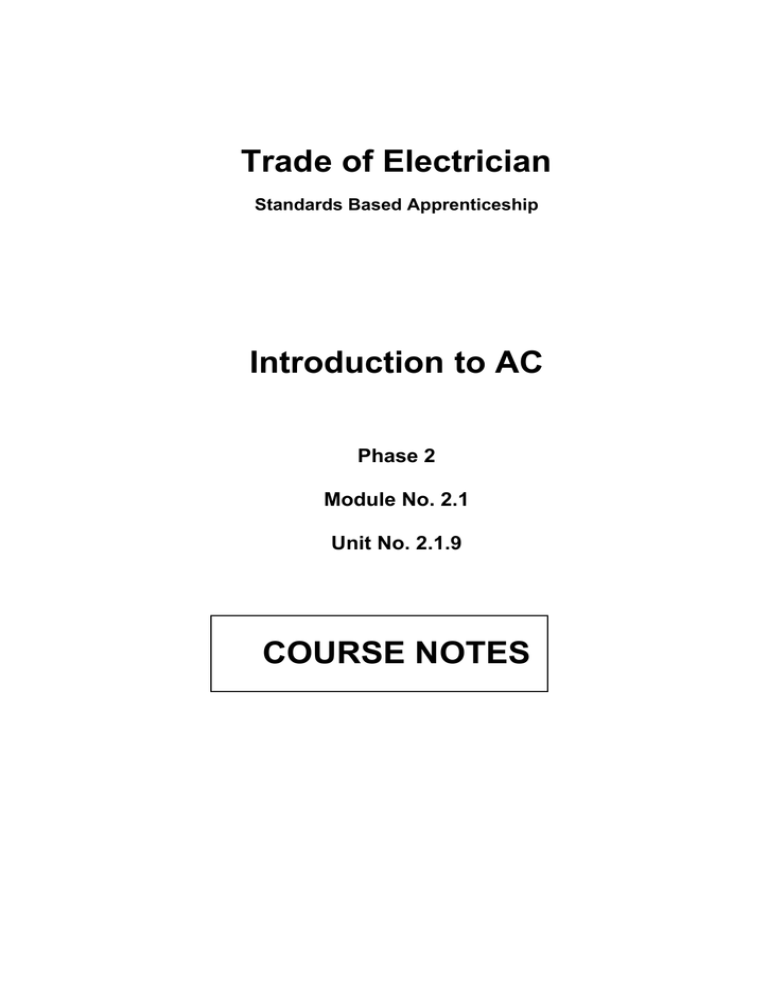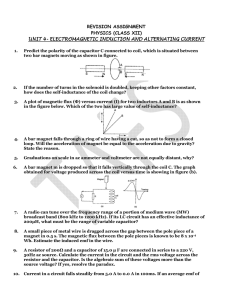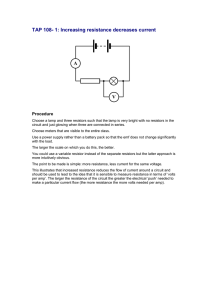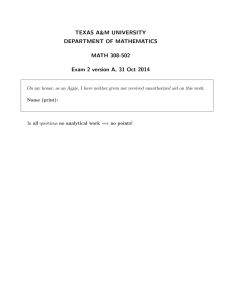
Trade of Electrician
Standards Based Apprenticeship
Introduction to AC
Phase 2
Module No. 2.1
Unit No. 2.1.9
COURSE NOTES
Created by Gerry Ryan - Galway TC
Revision 1. April 2000 by
Gerry Ryan - Galway TC
John Watters - Sligo TC
Revision 2. Nov. 2002 by
Gerry Ryan - Galway TC
Chris Ludlow - DundalkTC
Revision 3. Aug 2006 by
Chris Ludlow - DundalkTC
Revision 4. Feb 2008 by
Chris Ludlow - DundalkTC
Revision 5, November 2013
SOLAS
Published by
27-33 Upper Baggot Street
Dublin 4
Ireland
© SOLAS - 2013
All rights reserved. No part of this publication may be reproduced, stored in a retrieval system or
transmitted in any form or by any means, electronic, mechanical, photocopying, recording or
otherwise, without the prior permission of the copyright owner.
SOLAS
Electrical Course Notes - Unit 2.1.9
Table of Contents
INTRODUCTION ......................................................................................................................................... 4
ALTERNATING CURRENT GENERATOR ............................................................................................ 5
GENERATION OF AN ALTERNATING EMF ........................................................................................ 6
FREQUENCY ................................................................................................................................................ 8
AC WAVEFORM VALUES ....................................................................................................................... 10
PURELY RESISTIVE AC CIRCUITS ..................................................................................................... 13
ELECTRICITY DISTRIBUTION NETWORK ....................................................................................... 19
DIRECT CURRENT ( DC ) GENERATOR ............................................................................................. 20
3
Revision 5, November 2013
SOLAS
Electrical Course Notes - Unit 2.1.9
Introduction
Welcome to this section of your course, which is designed to introduce you the learner, to
Alternating Current theory.
Objectives
By the end of this unit you will be able to:
Understand the basic principle of a simple AC generator
Understand how an alternating EMF is generated
Explain the term “frequency”
Understand the terms Peak, RMS and Average values of a sine wave
State the effect of a resistor in an AC circuit
State the effect of a capacitor in an AC circuit
State the effect of an inductor in an AC circuit
List fuels used to generate electricity in Ireland
State ESB distribution network voltages
Understand the basic principle of a simple DC generator
Reasons
Almost all electricity is generated as AC, so it is very important to understand the effects of
these components.
4
Revision 5, November 2013
SOLAS
Electrical Course Notes - Unit 2.1.9
Alternating Current Generator
The basic principle of an AC generator is shown in Figure 1. The coil ends are connected to two
slip rings.
B
A
N
S
AC Output
Carbon Brush
Slipring
Figure 1.
As the coil sides A and B are rotated by an external force side A will have an EMF induced first
in one direction and then in the other direction.
As side A of the coil is permanently connected to one slip ring, this ring will alternate from
positive to negative as coil side A rotates past the North and South pole faces. The same
process applies to coil side B. The generated output is therefore alternating ( AC ).
The direction of the induced EMF in each coil side can be determined by the use of Fleming’s
Right Hand Rule.
5
Revision 5, November 2013
SOLAS
Electrical Course Notes - Unit 2.1.9
Generation of an Alternating EMF
Figure 2 shows a cross-section through a single loop generator.
N
B
A
Direction
of
Rotation
Pivot
S
Figure 2.
As the single loop coil AB is being rotated anticlockwise about its pivot we will consider what
voltage, if any, is being induced into this coil at definite intervals throughout a 3600 cycle of
rotation, starting at positions 1 and 7, see Figure 3.
Figure 3.
When the coil sides A and B are rotating parallel to the lines of magnetic flux and hence not
cutting any lines of magnetic flux no EMF is being induced in them. This is illustrated in Figure
3, by positions 1 and 7,
6
Revision 5, November 2013
SOLAS
Electrical Course Notes - Unit 2.1.9
As the coil AB is rotated further anticlockwise, it can be seen that the coil is cutting magnetic
flux lines and hence an EMF is induced into it. This is illustrated in Figure 3, by positions 2 and
8. The magnitude of this EMF is as shown at position 2 of the sine wave.
As the coil AB is rotated further anticlockwise through positions 3 and 9, and then to positions
4 and 10 where the maximum flux is being cut resulting in the maximum voltage being induced
into the coil as illustrated at position 4, see Figure 3.
As the induced EMF in the coil AB depends on the amount of flux being cut, which itself
depends on the position of the coil, then the magnitude of the induced EMF can be represented
by the coil position.
The resulting graph, Figure 4, indicates the EMF induced in the coil for one complete
revolution of the coil. The resultant waveform is called a sine wave.
A sine waveform consists of equal positive and negative half cycles.
Positive Half Cycle
+
E
M 0
F
-
Time
Negative Half Cycle
One complete Cycle
Figure 4.
Figure 4 shows the variation of the induced EMF during one complete revolution of a coil and
is termed one cycle.
7
Revision 5, November 2013
SOLAS
Electrical Course Notes - Unit 2.1.9
Frequency
If the loop is rotated at the speed of 2 revolutions each second, the resultant EMF will complete
2 cycles each second. The number of cycles each second is referred to as frequency.
+
0
EMF
Time
Two Complete Cycles
The symbol for frequency is ( f ). It is measured in cycles per second ( CPS ) or more
commonly Hertz ( Hz ). The time in which one cycle is completed is known as the periodic
time. A frequency of 50 Hz is the standard for the supply system in Ireland.
The frequency of a supply can be calculated as follows:
f
1
=
T
Where:
f
1
T
=
=
=
frequency in Hertz ( CPS )
constant
periodic time ( the time in which one cycle is completed )
8
Revision 5, November 2013
SOLAS
Electrical Course Notes - Unit 2.1.9
Example 1
An alternating voltage waveform has a periodic time of 4 mS. Calculate the frequency of the
supply?
Solution
T
=
f
=
f
=
4mS
=
4 x 10-3 S
1
T
1
4 x 10-3
103
f
=
4
f
=
250 Hz
Example 2
Calculate the periodic time of a supply, which has a frequency of 50 Hz.
Solution:
f
=
T
=
50
1
f
1
T
=
50
T
=
0.02 Seconds ( or 20 mS )
9
Revision 5, November 2013
SOLAS
Electrical Course Notes - Unit 2.1.9
AC Waveform Values
Figure 6 shows the Peak, Root Mean Square and Average values for a 1 Volt AC supply. These
values also apply to the negative half cycle.
1.0 V.+
Peak
0.707 V.
0.637 V.
RMS
Average
0 V.
Time
Figure 6
Peak Value of a Waveform
The Peak value is simply the highest value on the waveform. It is also known as the Maximum
value. The peak value of the waveform in Figure 6 is 1 Volt.
This may be written as VP = 1 Volt.
Root Mean Square Value of a Waveform
If you measure the mains supply you will find it to be 230 Volts.
This is the Root-Mean- Square ( RMS ) value of the alternating voltage. It is also known as
the Effective value. The RMS value of the waveform in Figure 6 is 0.707 Volt.
This may be written as VRMS = 0.707 Volt.
The RMS value of an AC voltage or current is defined as the equivalent DC value, which
would have the same heating effect. The RMS or Effective value is the value normally used.
All multimeters are designed to read RMS values.
Average Value of a Waveform
The Average value of a waveform is calculated over one half of a cycle. It is also known as the
Mean value. The average value of the waveform in Figure 6 is 0.637 Volt. This may be written
as VAVE = 0.637 Volt. It is simply the mathematical average value of the positive or negative
half cycle. If an attempt is made to average an alternating waveform over a complete cycle, the
negative half of the waveform will cancel the positive half, and so the result is zero.
10
Revision 5, November 2013
SOLAS
Electrical Course Notes - Unit 2.1.9
Relationship Between Waveform Values
If you measure the mains supply with a multimeter you will find it to be about 230 Volts.
Remember, this is the RMS value. From this, the peak value can be calculated as follows:
Peak Value
=
Peak Value
=
Peak Value
=
RMS Value
0.707
230
0.707
325 Volts
The Peak or Maximum Value of the 230 Volt mains supply is about 325 Volts. Please note that
325 Volts will be across your body if you receive an electric shock from the 230 Volt mains.
Now that we know the peak value of the supply, the average value can be calculated as follows:
Average Value
=
Peak Value x 0.637
Average Value
=
325 x 0.637
Average Value
=
207 Volts
The average or mean value is rarely used, except in some electronic circuits, e.g. rectifier
circuits.
Given the peak value of the supply, the RMS value may be calculated as follows:
RMS Value
=
Peak Value x 0.707
RMS Value
=
325 x 0.707
RMS Value
=
230 Volts
Given the average value of the supply, the peak value may be calculated as follows:
Peak Value
=
Peak Value
=
Peak Value
=
Average Value
0.637
207
0.637
325 Volts
11
Revision 5, November 2013
SOLAS
Electrical Course Notes - Unit 2.1.9
Example
The peak value of a sine wave is 12 Volts and it has a periodic time of 16 mS.
Calculate the following:
(1)
(2)
(3)
(4)
RMS value
Average value of full wave
Average value of half wave
Frequency of supply.
Solution
(1)
RMS value
=
Peak value x 0.707
RMS value
=
12 x 0.707
RMS value
=
8.484 Volts
(2)
(3)
(4)
Average value of full wave = 0, since the negative half cancels the positive half
exactly.
Average value of half wave
Average value
=
Peak value x 0.637
Average value
=
12 x 0.637
Average value
=
7.644 Volts.
Frequency of Supply
f
=
f
=
f
=
f
=
f
=
1
T = 16 mS = 16 x 10-3 mS
T
1
16 x 10-3
103
16
1000
16
62.5 Hz
12
Revision 5, November 2013
SOLAS
Electrical Course Notes - Unit 2.1.9
Purely Resistive AC Circuits
Effect of Resistance in DC and AC Circuits
Purely resistance circuits consist of electrical devices, which contain no inductance or
capacitance. Devices such as resistors, lamps ( incandescent ) and heating elements have
negligible inductance or capacitance and for practical purposes can be considered to be purely
resistive. For such AC circuits the same rules and laws apply as for DC circuits.
Refer to Figure 7.
A
+
Resistor
100R
10VDC
-
I
=
I
=
I
=
U
Figure 7
R
10
100
0.10 Amp.
In the AC circuit shown in Figure 8 there is an alternating supply of 10 Volts RMS applied.
This circuit will draw the same current as the DC circuit above.
..
A
Resistor
100R
10 Volts AC
RMS
Figure 8
In an AC circuit with only resistance present:
I
=
U
R
When an AC circuit contains only resistive devices, Ohms Law, Kirchoff’s Laws, and the
Power Laws can be used in exactly the same way as in DC circuits.
13
Revision 5, November 2013
SOLAS
Electrical Course Notes - Unit 2.1.9
The Effect of Capacitance in DC and AC Circuits
Figure 7 shows a DC supply connected to a non polarised capacitor. When the supply is
switched on, the ammeter will indicate current flowing initially, and then the reading will fall
off to zero. This indicates that the capacitor is charged. Because there is virtually no resistance
in the circuit, the charging of the capacitor is almost instantaneous.
In a DC circuit containing only capacitance, no current flows after the initial charging
current.
A
+
Capacitor
-
Figure 7
Figure 8 shows a lamp connected in series with a non-polarised capacitor across 12 V DC
supply. When the switch is closed, the lamp may flicker “on” for an instant as the charging
current flows through it.
This current flow reduces to zero as the capacitor charges to full capacity. At this stage the
applied voltage is across the terminals of the capacitor and the voltage across the lamp has
reduced to zero.
Switch
Capacitor
+
12VDC
Lamp
Figure 8
14
Revision 5, November 2013
SOLAS
Electrical Course Notes - Unit 2.1.9
Figure 9 shows the same circuit now connected to an AC supply.
When the switch is closed, the capacitor is charged with one polarity and then it discharges;
next the capacitor is charged with the opposite polarity, and then it discharges again.
The cycles of charge and discharge current provide an alternating current in the circuit,
at the same frequency as the applied voltage. This is the current, which lights the lamp.
Switch
Capacitor
12VAC
RMS Value
Lamp
Figure 9
Figure 10 shows the same circuit with a lower value capacitor. This capacitor takes a lower
value charge and discharge current and therefore the lamp will be dimmer. The lower value
capacitor has more opposition to alternating current and so less current flows in the circuit.
From this we can see that the circuit has more reactance for less capacitance.
Switch
Capacitor
12VAC
RMS Value
Lamp
Figure 10
Capacitive Reactance is the opposition offered to the flow of alternating current in a circuit
containing a capacitor.
X
=
Reactance
Capacitive Reactance is measured in Ohms and is denoted in a circuit by the symbol XC.
15
Revision 5, November 2013
SOLAS
Electrical Course Notes - Unit 2.1.9
Summary:
When DC is applied to a circuit containing a capacitor in series with a lamp, the
capacitor acts, as a blocking device and the lamp does not light.
When AC is applied to a circuit containing a capacitor in series with a lamp, the
capacitor allows current to flow through the process of charging and discharging the
capacitor and as a result the lamp illuminates.
In an AC circuit containing a capacitor, the lower the capacitance value the lower the
current flow. This means that, the lower the capacitor value, the greater the opposition
to current flow. This opposition is known as Capacitive Reactance ( XC ).
A discharged capacitor behaves like a closed switch.
A charged capacitor behaves like an open switch.
16
Revision 5, November 2013
SOLAS
Electrical Course Notes - Unit 2.1.9
The Effect of Inductance in DC and AC Circuits
Inductance is only effective in a circuit when current is changing. The reason for this is that a
changing current results in a changing magnetic field, which in turn produces a back EMF.
In a DC circuit, the effect described above occurs only when circuit current is changing.
At “Switch On” ( an increasing current causing an expanding magnetic field ) and
at “Switch Off” ( a decreasing current causing a collapsing magnetic field ).
Some inductors have a very low resistance and this will result in high currents flowing when
they are connected in DC circuits.
Switch
+
Choke
Figure 13
Figure 14 shows a DC supply connected to a circuit consisting of an inductor, which has an
inductance value of 1 Henry and a resistance value 1 Ohm, in series with a lamp.
When the DC supply is switched on, the lamp will be bright. This indicates that the inductor has
little opposition to current flow in the circuit.
Switch
Inductance = 1 Henry
Resistance = 1 Ohm
+
12VDC
Lamp
12V 0.1A
-
Figure 14
17
Revision 5, November 2013
SOLAS
Electrical Course Notes - Unit 2.1.9
Figure 15 shows the same circuit now connected to an AC supply.
It must be remembered that an alternating current is continuously changing, i.e. the current is
rising and falling. This results in a magnetic field which is continuously changing in strength
and polarity. As a result of this the inductor has a continuous effect on an AC circuit.
For the circuit shown there will be a back EMF induced in the inductor, which according to
Lenz’s Law opposes the supply voltage. This in turn opposes the current flow in the circuit.
Switch
Inductance = 1 Henry
Resistance = 1 Ohm
12VAC
50 Hz
Lamp
12V 0.1A
Figure 15
The opposition to the flow of alternating current in the inductor, is called Inductive Reactance,
symbol ( XL ). Inductive reactance in common with capacitive reactance and resistance is
measured in Ohms. The resistance of the coil will depend on the CSA, length and type of wire
used in its construction.
Although the inductor in the circuit has a resistance of 1 Ohm, it has an Inductive Reactance of
314 Ohms approximately, under the circuit conditions described. The lamp will be dim,
indicating a high opposition to current flow. Contrast this with the DC circuit, dealt with
previously, where the lamp was bright.
18
Revision 5, November 2013
SOLAS
Electrical Course Notes - Unit 2.1.9
Electricity Distribution Network
The Electricity Supply Board ( ESB ) operates 19 major power stations and is responsible for
the generation, transmission and distribution of electricity in Ireland. The ESB is also the
largest provider of renewable power, with hydro-electric power stations on the Erne, the
Shannon, the Lee and the Liffey. A wholly-owned subsidiary of ESB, Hibernian Wind, is
developing and operating wind farms.
Generation of Electricity
Many types of fuel are used to create steam and rotate turbines, which are coupled to 3-Phase
AC generators. These generators produce electricity at 10,000 Volts ( 10kV ) 50 Hz.
A sample of the range of energy sources used by ESB generating stations is as follows:
Coal
Gas
Hydro
Oil
Oil / Gas
Peat
Pumped Storage
( Moneypoint )
( Aghada )
( Ard na Chrusha )
( Tarbert )
( Poolbeg )
( Shannonbridge )
( Turlough Hill )
Distribution of Electricity
The National Grid is an electricity transmission network of lines and cables throughout the
country. It operates at very high voltages ( up to 400,000 Volts ).
At power stations, electricity is transformed to the higher voltage levels of 110,000, 220,000, or
400,000 Volts. It is then fed into a transmission network of approximately 6,000km of overhead
lines and underground cables. These cables carry the electricity throughout the country. This
network incorporates over one hundred high voltage transformer stations. At these stations the
voltage is reduced to distribution voltages of 38,000, 20,000 and 10,000 Volts. Some larger
industrial premises are supplied directly at these voltages.
Electricity is distributed at these 'medium' level voltages over an extensive distribution network
of 80,000km of overhead lines and underground cables to smaller local substations close to
customers' premises. At the local substations, it is finally transformed down to the normal
mains voltage level for use by customers.
By using very high voltages, the amount of energy that is wasted as heat, due to resistance in
the transmission cables is greatly reduced. For every doubling of the transmission voltage, the
amount of power wasted, is reduced by 75%.
19
Revision 5, November 2013
SOLAS
Electrical Course Notes - Unit 2.1.9
Direct Current ( DC ) Generator
The basic difference between the AC generator and the DC generator is the way the generated
EMF and current are extracted from the rotating coil, which cuts the magnetic field. In the case
of the AC generator the induced EMF is extracted via fixed carbon brushes in contact with the
rotating slip rings. In the case of the DC generator, the induced EMF is extracted via fixed
carbon brushes in contact with the rotating commutator, as shown in Figure 18. A simple DC
generator as shown, has a single loop coil with its ends connected to two copper segments
forming its commutator which is mounted on a shaft.
Figure 18
This output from the generator is a pulsating DC voltage as shown in Figure 19.
+
EMF
DC Output
0
-
One Revoloution
Figure 19
Practical DC generators have many conductor loops and commutators with large numbers of
segments so the output voltage can be almost constant.
20
Revision 5, November 2013





